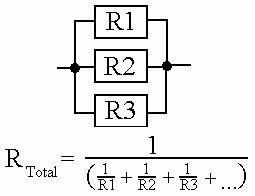Resistor Wattage
[Top]
 Different circuits have different power requirements, and to this extent you must ensure that you have resistors which can handle the amount of power without over heating or blowing up. Typical values for wattage sizes (measured in watts) are 1/4 W, 1/2 W, 1 W and 5 W.
Different circuits have different power requirements, and to this extent you must ensure that you have resistors which can handle the amount of power without over heating or blowing up. Typical values for wattage sizes (measured in watts) are 1/4 W, 1/2 W, 1 W and 5 W.
An easy way to calculate the wattage of a circuit is using the following formula with P = Power (W), V = Voltage (V) and I = Current (amps). To establish what formula you need to use, cover the symbol whose value you wish to know. This leaves a diagramatic representation of the required formula (eg: cover the P and your are left with V x I).
 A useful variation of this formula is P = I2.R where R is resistance in ohms. This is a combination of the Power formula and Ohm's Law.
A useful variation of this formula is P = I2.R where R is resistance in ohms. This is a combination of the Power formula and Ohm's Law.
|


